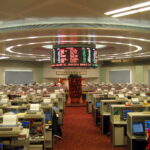The globalization of trade, cooperation and culture has been seen as an unstoppable force in international business and commerce.
In recent years several obstacles that could undermine decades of progress have appeared.
Statista reports that the rise of nationalism and protectionist policies are among the many factors changing the world’s trading landscape. This has led to some people wondering if globalisation is at its peak.
The impact of pandemic: a terminal decline
Global trade’s evolution has not been linear.
After decades of steady expansion, 2008’s financial crisis revealed flaws within the system.
The COVID-19 epidemic was the watershed event, causing world trade to plummet, reaching levels last seen in 2003.
World Bank noted a drop in trade to GDP ratio that highlighted the vulnerability of supply chains around the world, which rely heavily on international cooperation.
Is this a short-lived revival?
The global economy has shown a significant recovery since the outbreak.
In 2022 the ratio of trade to GDP had reached a staggering 62.8%. This indicates a return to levels prior to pandemic.
This quick recovery wasn’t without its challenges. The percentage dropped again in 2023 to 58.5%, which indicates potential volatility within the global trading environment.
Some industries have adapted quickly to the new rules. Others, however, are still struggling with supply chain disruptions.
Both companies and governments have realised the need to assess and redesign their supply chain in order to prevent the risks associated with global dependency.
As businesses negotiate complex business conditions and future regulatory uncertainty, it is difficult to predict the timetable of such changes.
Nationalism and protectionism: Emerging threats
The resurgence in nationalism is a major problem as globalisation tries to gain its footing.
In several countries, the politics has evolved towards protectionism in order to give priority to domestic industry over international trade.
The Trump administration has continued to fight trade wars in the United States. This includes imposing new tariffs on imported goods. It is further undermining the concept of free trade that was popularized during previous decades.
This protectionist tactic is not limited to the United States. Many countries around the globe are adopting similar policies, changing their tariffs and creating regulatory barriers which impede trade.
The current wave of nationalism not only hinders interoperability in the economy, but it also creates an atmosphere where trading partners are likely to retaliate against each other. This could result in a fragmentation of markets on a worldwide scale.
Uncertainty looms over the future of international trade
As nationalist sentiments increase and trade policies are shaped by protectionist measures, the future of globalisation remains uncertain.
Experts warn that while it’s difficult to predict the long-term effects of Trump’s trade policy, the new tariffs combined with shifting political priorities could have a significant impact on the global trade dynamics.
Modern supply chains are complex and require strategic planning as well as adaptability.
Businesses may find it beneficial to shift production close to home, or even diversify their suppliers.
This reconfiguration is time-consuming and expensive, adding to the uncertainty in the short term.
This article Is Globalization at a Crossroads? This post, Nationalism and Protectionism Threaten Trade Recovery may change as new information becomes available
This site is for entertainment only. Click here to read more






